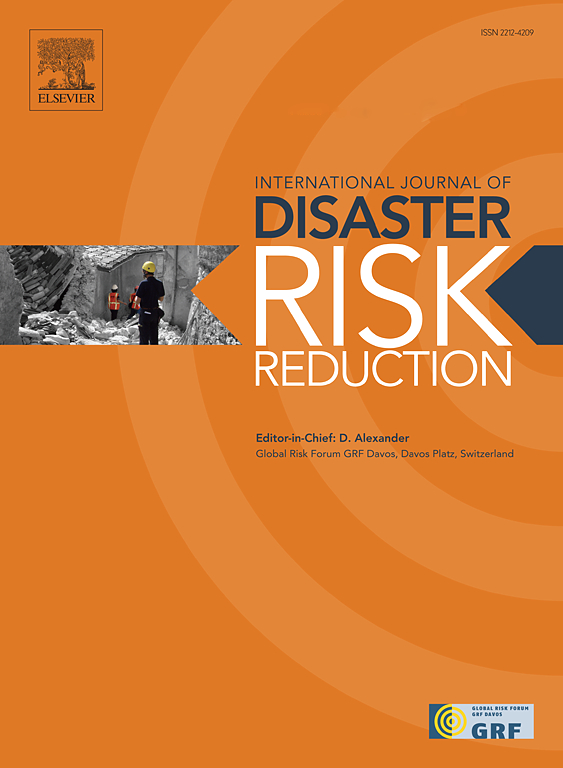Post-earthquake water demand modeling of water distribution systems considering population redistribution
IF 4.2
1区 地球科学
Q1 GEOSCIENCES, MULTIDISCIPLINARY
International journal of disaster risk reduction
Pub Date : 2024-09-27
DOI:10.1016/j.ijdrr.2024.104868
引用次数: 0
Abstract
To estimate the water demands of water distribution systems (WDSs) after earthquakes, a new method is proposed in this study to model the post-earthquake water demands of different user nodes in WDSs, relying on urban land use maps and resident population distribution. The method considers three key restoration phases: rescue, refuge, and reconstruction. The spatial distribution of post-earthquake population in various land parcels is first determined based on the empirical models of earthquake evacuees and casualties. Then, the water demands of a land parcel are estimated by multiplying the parcel's area by the corresponding post-earthquake water demand indices, along with the sum of water demands for ordinary residents, injured individuals, and evacuees in the land parcel. To allocate the water demands of different land parcels to user nodes, the service areas of different user nodes are determined using Thiessen polygons. Finally, the water demands of a land parcel are allocated to user nodes based on the percentage of the parcel's area within the service areas of the user nodes. The proposed method is applied to a WDS currently operating in a typical city located in high seismic intensity region. The numerical results, in terms of the water demands of the whole network and different user nodes, are compared with those obtained from two existing methods. The influence of seismic intensity on the water demands of different user nodes is also investigated in this study. The numerical results show that in the proposed method, the post-earthquake water demands of WDSs increase in the three restoration phases, which is consistent with the post-earthquake survey of WDSs after the 2008 Wenchuan earthquake, indicating the rationality of the proposed modeling method.
考虑到人口重新分布的地震后配水系统水需求建模
为估算地震后配水系统(WDS)的需水量,本研究提出了一种新方法,以城市土地利用图和常住人口分布为基础,对配水系统中不同用户节点的震后需水量进行建模。该方法考虑了三个关键的恢复阶段:救援、避难和重建。首先,根据地震疏散和伤亡的经验模型确定不同地块的震后人口空间分布。然后,将地块面积乘以相应的震后需水指数,再加上地块内普通居民、伤员和避难人员的需水量之和,估算出地块的需水量。为了将不同地块的需水量分配给用户节点,使用 Thiessen 多边形确定不同用户节点的服务区域。最后,根据用户节点服务区内地块面积的百分比,将地块的需水量分配给用户节点。我们将所提出的方法应用于一个位于高地震烈度地区的典型城市中正在运行的自来水厂。就整个管网和不同用户节点的需水量而言,数值结果与两种现有方法得出的结果进行了比较。本研究还探讨了地震烈度对不同用户节点需水量的影响。数值结果表明,在所提出的方法中,震后用水需求在三个恢复阶段均有所增加,这与 2008 年汶川地震后对用水需求的震后调查相一致,说明所提出的建模方法是合理的。
本文章由计算机程序翻译,如有差异,请以英文原文为准。
求助全文
约1分钟内获得全文
求助全文
来源期刊

International journal of disaster risk reduction
GEOSCIENCES, MULTIDISCIPLINARYMETEOROLOGY-METEOROLOGY & ATMOSPHERIC SCIENCES
CiteScore
8.70
自引率
18.00%
发文量
688
审稿时长
79 days
期刊介绍:
The International Journal of Disaster Risk Reduction (IJDRR) is the journal for researchers, policymakers and practitioners across diverse disciplines: earth sciences and their implications; environmental sciences; engineering; urban studies; geography; and the social sciences. IJDRR publishes fundamental and applied research, critical reviews, policy papers and case studies with a particular focus on multi-disciplinary research that aims to reduce the impact of natural, technological, social and intentional disasters. IJDRR stimulates exchange of ideas and knowledge transfer on disaster research, mitigation, adaptation, prevention and risk reduction at all geographical scales: local, national and international.
Key topics:-
-multifaceted disaster and cascading disasters
-the development of disaster risk reduction strategies and techniques
-discussion and development of effective warning and educational systems for risk management at all levels
-disasters associated with climate change
-vulnerability analysis and vulnerability trends
-emerging risks
-resilience against disasters.
The journal particularly encourages papers that approach risk from a multi-disciplinary perspective.
 求助内容:
求助内容: 应助结果提醒方式:
应助结果提醒方式:


